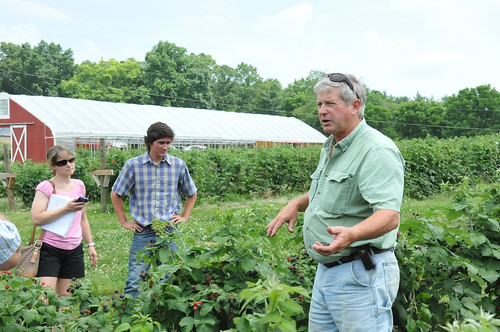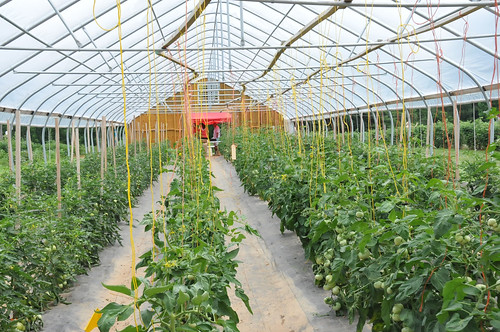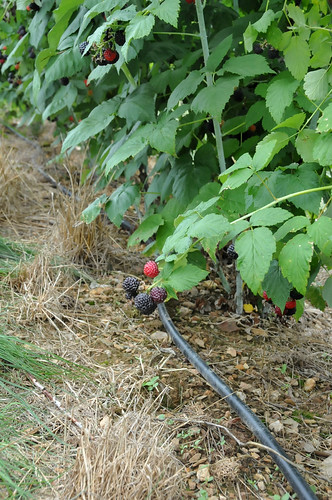
Wade Butler talks about how drip irrigation system benefits black raspberries on his farm.
A farmer’s field is dotted with people busily picking blueberries off bushes and loading them into large red buckets. But they’re not at work. They’re picking for their own pantries.
Butler’s Orchard, located near Washington, D.C. in Germantown, Maryland, is a 300-acre family-owned farm that grows more than 180 crops including 25 different kinds of vegetables, fruits and flowers. For the past 60 years, this farm has opened its rows and orchards for people to pick their own.
Growing a variety of crops can take some unique farming tools and techniques, and Wade Butler, the farm’s manager, turned to USDA’s Natural Resources Conservation Service for help.
Butler worked with NRCS to build an irrigation system and a seasonal high tunnel to improve both efficiency and crop yield on the farm.
Butler has two ponds on his farm that feed the drip irrigation system that waters the crops. “With the recent irrigation practices we worked on with NRCS, we were able to expand our fruit crops,” Butler said. “We were able to bury the pipes underground for drip irrigation. This makes our farm more efficient with water because we can water the crops and not just the weeds.”
Along with the irrigation system, Butler received funding through NRCS for a seasonal high tunnel where he grows heirloom tomatoes.

Tomatoes grow in a high tunnel at Butler’s Orchard. The high tunnel provides a longer growing season and increased protection for valuable crops.
Seasonal high tunnels are plastic-covered structures that enable farmers to have crops ready earlier or later in the season. In high tunnels, plants are grown directly in the ground, and the temperature is regulated by opening or closing the plastic curtain sides and doors on the ends.
“With the high tunnel, there is less disease, which can in turn give me a higher value on my crops,” he said.
Both practices are funded through NRCS’ Environmental Quality Incentives Program.
High tunnels are especially important for summer crops, like tomatoes. Plus, they can enable wise use of water and other inputs while protecting against pests. High tunnels are a popular conservation practice in Maryland, and Butler’s is one of 130 built in the state with NRCS help since 2010.
“Butler’s high tunnel is a conservation practice that helps to extend the growing season for high value crops in an environmentally safe manner,” said Jim Myers, NRCS district conservationist in Howard and Montgomery counties. “Plus, the drip irrigation comes from the Butler’s pond into the high tunnel, which increases water efficiency.”
Butler is no stranger to conservation as he has served more than 15 years on the Montgomery County Soil and Water Conservation District board. While recognizing the importance of conservation, Butler knows where the heart of the farming experience is.
“It’s always great to get positive feedback from families who come to farm with their kids,” he said. “It’s become a generational experience for some adults whose parents took them to Butler’s when they were kids to pick fruits and vegetables.”
The farm has about 100 employees. In addition to fruits and vegetables, Butler’s Orchard has moved into “agri-tainment” at the farm. For 23 years, Butler’s has hosted fall and spring festivals where families, camps and school groups can take hayrides, ride trolleys, pick fruits, vegetables and pumpkins, and even hunt for Easter eggs.
Families come from the region to have fun experiencing the giant slides, pony rides and straw maze. Many families have also made it a family tradition to visit Butler’s Orchard to get their Christmas tree.
To get started with NRCS, visit your local USDA Service Center or www.nrcs.usda.gov/GetStarted.

A drip irrigation line runs next to a row of black raspberry bushes at Butler’s orchard. Drip irrigation reduces runoff and evaporation by applying water slowly at the plant root zone where it is needed.
No comments:
Post a Comment
Note: Only a member of this blog may post a comment.